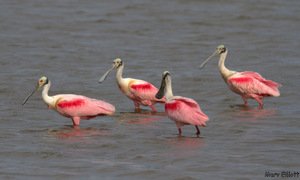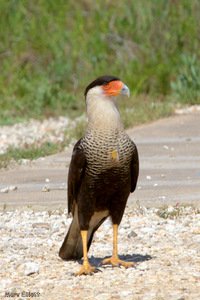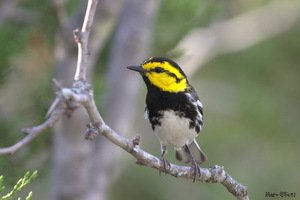A program on birding in Texas, It's Not Just Cactus and Cowboys, will be presented on April 8 at 7 pm at the Brandon Library and again on May 5 at 7 pm at the Rutland Free Library Fox Room.
The following article appeared in the RCAS newsletter in 2007. It highlights some other places to bird in Texas in the spring:
 Roseate SpoonbillsTo birders, the lure of a spring trip to Texas is irresistible – warm weather, birds that can be seen nowhere else in the U.S. and the opportunity to observe some of our familiar species up close as they make their way north. In April 2007 Marv and I spent a month there; it was a month well spent. We had visited Texas before, but never just to bird. We had read about places like goose Island, South Padre Island, Falcon Dam, Big Bend National Park and the Davis Mountains so the attraction was great to go back and try our skills (and cross our fingers for luck) at finding the Texas specialties.
Roseate SpoonbillsTo birders, the lure of a spring trip to Texas is irresistible – warm weather, birds that can be seen nowhere else in the U.S. and the opportunity to observe some of our familiar species up close as they make their way north. In April 2007 Marv and I spent a month there; it was a month well spent. We had visited Texas before, but never just to bird. We had read about places like goose Island, South Padre Island, Falcon Dam, Big Bend National Park and the Davis Mountains so the attraction was great to go back and try our skills (and cross our fingers for luck) at finding the Texas specialties.
We left on March 26, just about the time winter has become about four weeks too long and spring in Vermont is still a ways off. We traveled by car, taking our pop-up camper. This gave us some flexibility in detouring to interesting places along the way. It was also an affordable way to travel and cover a big area over four weeks. We armed ourselves with two guidebooks on birding. Birding Texas by Roland H. Wauer and mark A. Elwonger and Exploring the Great Texas Coastal Birding Trail by Mel White. The ABA Birders Guide to the Rio Grand Valley is also a great resource. We also took along one general guidebook, the Moon Handbook to Texas by Joe Cummings, which was invaluable for learning about the local culture and history and, very importantly, the local cuisine.
We arrived at Caddo Lake State Park in east Texas in about four days (we could have made it in three, but stopped to visit relatives along the way). Texas State Parks are wonderful places to stay; besides being affordable, they are often great birding areas as well as good places to meet fellow birders. Texas State Parks are frequently staffed with ‘birding hosts,’ who offer birding trips and can provide hot tips on the best places to bird inside and outside the park. Caddo Lake was no exception. Within minutes of our arrival we had spotted Yellow-throated Warbler and Prothonotary Warbler. As we leaned on the railing of a fishing pier jutting out into the cypress swamp, a Northern Parula landed at our elbows – quite a different view of parulas in Vermont where we crane our necks to catch fleeting glimpses in the treetops!
 Crested CaracaraOur next stop was Brazos Bend State Park, just outside of Houston, a great park in itself and a good jumping off point for other birding hotspots such as Brazoria National Wildlife Refuge (Roseate Spoonbills!) and San Bernard National Wildlife Refuge. The birding at Brazos Bend is great with 26 miles of hiking trails around small lakes that are filled with waterfowl, songbirds and raptors. The Black-bellied Whistling Duck became a favorite, a bird that manages to be comical and beautiful at the same time. White Ibis is also abundant here and was a new species for us. Another new species was alligator! Frequently the trails would be littered with the sunning reptiles so we soon learned to have an alternate route in mind. It was also alligator mating season and their bellowing added to the prehistoric feel of the rich bottomland forest.
Crested CaracaraOur next stop was Brazos Bend State Park, just outside of Houston, a great park in itself and a good jumping off point for other birding hotspots such as Brazoria National Wildlife Refuge (Roseate Spoonbills!) and San Bernard National Wildlife Refuge. The birding at Brazos Bend is great with 26 miles of hiking trails around small lakes that are filled with waterfowl, songbirds and raptors. The Black-bellied Whistling Duck became a favorite, a bird that manages to be comical and beautiful at the same time. White Ibis is also abundant here and was a new species for us. Another new species was alligator! Frequently the trails would be littered with the sunning reptiles so we soon learned to have an alternate route in mind. It was also alligator mating season and their bellowing added to the prehistoric feel of the rich bottomland forest.
Acting on a tip from a local birding expert, we visited Quintana, a tiny woodlot along the gulf that acts as a ‘migrant trap,’ a patch of greenery that is irresistible to travelling songbirds. In one binocular view was a study in red: a Scarlet Tanager, a Summer Tanager and a Northern Cardinal! Worm-eating Warbler was new for us here.
It was hard to leave Brazos Bend, but we had heard a lot about our next stop, Goose Island State Park. It was Easter and Texas State Parks can be quite the madhouses over a spring holiday weekend. Unfortunately for many Texans, the weather was a washout as it was for most of the U.S. as it left the state park virtually empty but for a few birding diehards. The birding went from great to spectacular over the next few days as we enjoyed Goose Island and other spots in the area. Buff-bellied Hummingbird, Blue Grosbeak and Dickcissel were new for us at Goose Island.
Aransas National Wildlife Refuge, the winter home of the rare and endangered Whooping Crane, is nearby. Although the cranes had already departed, there was still plenty to enjoy. Acres of salt marsh, thick brushy cover and stretches of sandy beaches provide great habitat for migrating and resident birds. Weather that can be a mere annoyance to people can be a big and life-threatening obstacle for birds. At Aransas we saw dozens of Barn Swallows too exhausted to move off the road after the recent storm. As birders we were thrilled to see these birds so closely, but we also recognized the need for protective shelter of places like Aransas where birds can recuperate before continuing north.
The weather was especially dismal at Padre Island National Seashore, but we had the opportunity to see more Upland Sandpipers than we could ever hope to see in a lifetime in Vermont along with a good variety of other shorebirds and terns. We were also treated to the improbably sight of seven Orchard Orioles huddle din the only shrub visible for miles.
 For some South Padre Island conjures up images of wild college students on spring break, but for birders it’s a different story. As we pulled into the private campground that was to be our home for the next few days, we spotted several Hooded Warblers. Our campsite by the Laguna Madre gave us up-close views of Little Blue Heron, Tricolored Heron and Reddish Egret as well as vivid sunsets. The small shrub in front of our camper frequently held Tennessee Warbler, Black-and-white Warbler, American Redstart and Common Yellowthroat.
For some South Padre Island conjures up images of wild college students on spring break, but for birders it’s a different story. As we pulled into the private campground that was to be our home for the next few days, we spotted several Hooded Warblers. Our campsite by the Laguna Madre gave us up-close views of Little Blue Heron, Tricolored Heron and Reddish Egret as well as vivid sunsets. The small shrub in front of our camper frequently held Tennessee Warbler, Black-and-white Warbler, American Redstart and Common Yellowthroat.
From South Padre we easily drove to Laguna Atascosa National Wildlife Refuge. With 45,000 acres it is also an invaluable bird oasis among all the development of coastal Texas. We spent the day, hiking and taking the auto route and tallying 70 species. Plain Chachalaca, Least Grebe, Crested Caracara, Great Kiskadee, Green Jay and Bronzed Cowbird were highlights here.
The Sabal Palm Audubon Sanctuary is also an easy drive from South Padre Island. Sabal Palm, as Texas’s only native palm tree, is an important component of an ecosystem that once stretched 80 miles along the coast, but is now reduced to a remnant. Here we saw a Least Grebe sitting on its floating nest and watched a graceful Swallow-tailed Kite in flight. Golden-fronted Woodpeckers, Great Kiskadees and Black-crested Titmice were carrying nesting material.
Before we left South Padre Island, we visited the Convention Center. We were skeptical at first, especially as we found the center being set up for a motorcycle gathering. But we quickly saw the attraction – a small grove of trees, literally dripping with birds. Two particular birds were noteworthy. First, was a Painted Bunting, which we had wanted to see for ages. Wow! And second, was a Yellow-billed Cuckoo. The cuckoo was perched in a small tree, about five feet from the ‘bird paparazzi’ armed with the latest and largest in photographic equipment. The bird, although healthy looking, was probably exhausted from migration and hungry. It dropped to ground to pick up a caterpillar. Flying back to its perch, it promptly dropped it and the crow let out a collective ‘Awww…’
Falcon State Park was next on the schedule. It is a 570-acre park on the Mexican border. You know you’re in the desert. Our car thermometer registered 102 degrees and all signs of the tropical coastal environment were gone. Texas is known for its extremes of habitat and weather and here was another taste of it. Chihuahuan Raven, Cactus Wren and Pyrrhuloxia reflected this change. The heat was too much for us after two days so it was time to move on. Before we left, though, we experienced a treat. A neighboring camper offered us a look at a Greater Roadrunner in her campsite – it was sitting on a nest!
Eager for the shade of trees and some cooler weather, we packed up. But before leaving the desert, we stopped to the see the White-collared Seedeater in San Ygnacia, a tiny speck of a bird in a tiny speck of a town. This species is seen in only a couple of spots north of the Rio Grande. We have to confess we barely knew of this bird’s existence until we were tipped off by fellow travelers, birders, who are always generous in sharing their knowledge.
 Golden-cheeked WarblerLocated in the Hill Country, Lost Maples State Natural Area is a delightful campground. It is home to the Uvalde Bigtooth Maple, a remnant of the Pleistocene Era. Its brilliant colors attract tourists in autumns the way our sugar maples in Vermont attract leaf peepers. Spring is the time to be here, however, for birders. The main attraction is the Golden-checked Warbler, a bird that can be found in the breeding season in the juniper-oak woodlands of Texas. It is not a hard bird to locate; its song (and its appearance) are similar to our Black-throated Green Warbler. We were fortunate to have several close up looks. We were also lucky to see the Black-throated Vireo, another specialty of the area. Lost Maples offers a good opportunity to hike and bird. The Hill Country is beautiful and, even if you didn’t see a single bird, the wildflowers along would make the trip worthwhile.
Golden-cheeked WarblerLocated in the Hill Country, Lost Maples State Natural Area is a delightful campground. It is home to the Uvalde Bigtooth Maple, a remnant of the Pleistocene Era. Its brilliant colors attract tourists in autumns the way our sugar maples in Vermont attract leaf peepers. Spring is the time to be here, however, for birders. The main attraction is the Golden-checked Warbler, a bird that can be found in the breeding season in the juniper-oak woodlands of Texas. It is not a hard bird to locate; its song (and its appearance) are similar to our Black-throated Green Warbler. We were fortunate to have several close up looks. We were also lucky to see the Black-throated Vireo, another specialty of the area. Lost Maples offers a good opportunity to hike and bird. The Hill Country is beautiful and, even if you didn’t see a single bird, the wildflowers along would make the trip worthwhile.
We really looked forward to our next destination, Big Bend National Park, one of the most remote parks in the system, and a summer home for the Colima Warbler. We had visited Big Bend before, but had been too early to see the Colima. Located in the southwest area of Texas where the Rio Grande River makes a big turn, the park contains both mountains and desert and contains a wide variety of plants and animals that have had to adapt to some tough conditions. We steeled ourselves for the hike into Laguna Meadows and Boot Canyon, where the warbler is found. We set out early to avoid the hot weather and within two miles had seen our first Colima Warbler! We ended up hiking ten miles that day, seeing some wonderful scenery, and lots of great birds such as White-throated Swift, Mexican Jay, Violet-green Swallow and Scott’s Oriole.
Despite sore muscles, the next day we hike the Window Trail. Its only drawback is that the return trip is uphill! Nevertheless we were treated to Golden Eagle, Lucifer Hummingbird, Crissal Thrasher and Varied Bunting. It was a nice way to end our stay at Big Bend before heading off to our last Texas stop, the Davis Mountains.
 Western Scrub-JayDavis State Park is a 2,700-acre park in the middle of the West Texas panhandle, and was built by the Civilian Conservation Corps, to which many Texas state parks owe their existence. Western Kingbird, Western Scrub-Jay, Black-headed Grosbeak and Lesser Goldfinch showed us we were now truly in the west. An unsatisfying look at a pair of retreating Montezuma Quail (which gave us yet another reason to plan another trip to Texas), was offset by another experience that more than made up for it. Alerted by fellow birders, we learned of an Elf Owl residing in a utility pole between campsites 2 and 3. Each evening a crown would gather at said location and at the appointed time of 8:45, the owl would appear in the hole for several minutes before flying off into the night. Such a small bird, but what a thrill!
Western Scrub-JayDavis State Park is a 2,700-acre park in the middle of the West Texas panhandle, and was built by the Civilian Conservation Corps, to which many Texas state parks owe their existence. Western Kingbird, Western Scrub-Jay, Black-headed Grosbeak and Lesser Goldfinch showed us we were now truly in the west. An unsatisfying look at a pair of retreating Montezuma Quail (which gave us yet another reason to plan another trip to Texas), was offset by another experience that more than made up for it. Alerted by fellow birders, we learned of an Elf Owl residing in a utility pole between campsites 2 and 3. Each evening a crown would gather at said location and at the appointed time of 8:45, the owl would appear in the hole for several minutes before flying off into the night. Such a small bird, but what a thrill!
The habitat of the Davis Mountains provided a dramatic contrast to the beginning of our trip in the east Texas bayous and served as a reminder of how far we had traveled (almost 5,000) miles and how much we had seen (256 species). We had traveled from the bayous of east Texas to the mountain desert of west Texas. Although we were sad to be leaving, we had learned a lot, including the fact there is a lot more to see in Texas!